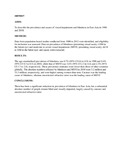| dc.description.abstract | AIMS:
To describe the prevalence and causes of visual impairment and blindness in East Asia in 1990 and 2010.
METHOD:
Data from population-based studies conducted from 1980 to 2012 were identified, and eligibility for inclusion was assessed. Data on prevalence of blindness (presenting visual acuity <3/60 in the better eye) and moderate to severe visual impairment (MSVI; presenting visual acuity <6/18 to 3/60 in the better eye) and causes were extracted.
RESULTS:
The age-standardised prevalence of blindness was 0.7% (95% CI 0.6 to 0.9) in 1990 and 0.4% (95% CI 0.3 to 0.5) in 2010, while that of MSVI was 3.6% (95% CI 2.3 to 4.4) and 2.3% (95% CI 1.7 to 2.8), respectively. These prevalence estimates were lower than those of other countries globally. The absolute numbers affected by blindness and MSVI in 2010 were 5.2 million and 33.3 million, respectively, and were higher among women than men. Cataract was the leading cause of blindness, whereas uncorrected refractive error was the leading cause of MSVI.
CONCLUSIONS:
There has been a significant reduction in prevalence of blindness in East Asia, but a substantial absolute number of people remain blind and visually impaired, largely caused by cataract and uncorrected refractive error. | en_US |

